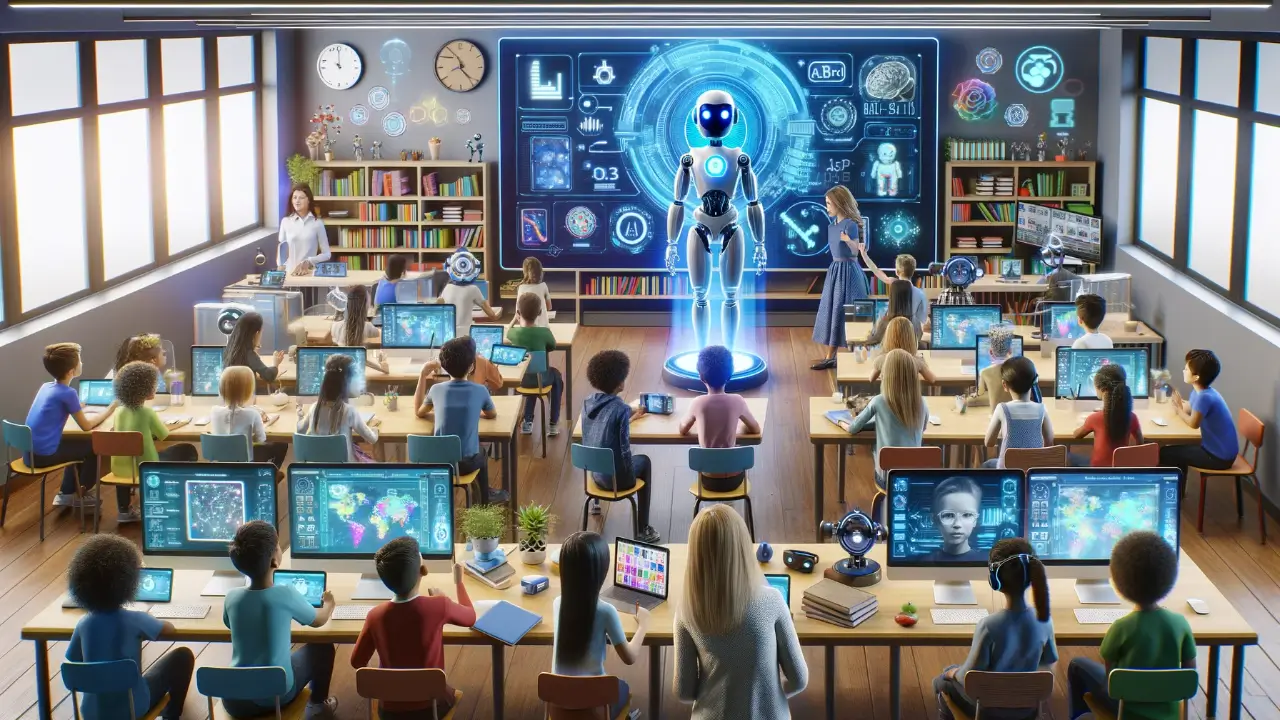Forget about outdated classrooms! AI has revolutionized the educational sector, creating a more personalized and engaging learning experience.
The traditional classroom setting has undertaken significant changes. Moreover, you do not need to sit in a four-walled room, a blackboard, a pile of books, or a blackboard.
Nowadays, the classroom is accessible to a wider range of audiences and allows people to use personalized options.
As AI is now fully functional, it benefits the educational sector.
In this article, we will emphasize AI’s emergence and its impact on teachers and the educational sector.
Ways AI Can Support Learning Experience
Here is a list of ways AI can support your learning experience.
1. AI-Enabled Research
You can significantly expedite access to pertinent materials study processes and seamlessly collaborate across various disciplines by utilizing AI-powered research discovery tools and collaborative workspaces.
Furthermore, predictive analytics can provide insights into the potential outcomes of their efforts, aiding in resource allocation and fostering groundbreaking work.
Thus, this comprehensive approach enhances research productivity, stimulates creativity, and facilitates the dissemination of knowledge.
2. Personal And Customized Learning
Education is receiving a personalized makeover!
Adaptive learning platforms utilize AI to analyze students’ data and adjust it with pace, difficulty, and content on the fly.
Hence, it ensures that each student receives a unique and innovative learning experience that matches their needs and preferences.
Therefore, mastery-based learning allows students to check their progress through the curriculum at their own pace. Similarly, the students get an opportunity to master every concept befire moving to the next.
3. Smart Classroom Management
The integration of advanced smart boards, which feature:
Interactive touch screens.
Multimedia capabilities.
Sophisticated attendance trackers.
Comprehensive classroom management software.
These features significantly streamline administrative duties, enhance communication, and refine classroom structure.
However, these technologies enable educators to create dynamic and engaging learning environments, facilitating seamless interaction among students, educators, and parents.
Additionally, Internet-of-Things devices, such as smart boards equipped with environmental sensors, improve classroom efficiency and increase student engagement by providing real-time data on environmental conditions and student interactions.
4. Automated Grading
AI offers a solution by eliminating the need for long working hours to assess and grade student tasks.
You can receive several rai feedback with an automated feedback and grading system. Similarly, you can free up time for more work and facilitate student interaction.
Therefore, individualized automatic feedback examines areas of competency and areas for improvement, fostering student knowledge and growth.
5. Personalized Student Support System
Students can seek help with academic or emotional issues with virtual assistance and AI-powered chatbots.
Therefore, based on student data, the counselling treatment tailors itself to foster a supportive environment and facilitate students’ achievements. Also, if you are wondering how to save money as a college student, AI has multiple answers. It can provide personalized recommendations for affordable textbooks, online resources, and budgeting tools tailored to your needs
Furthermore, it results in comprehensive support that helps them overcome barriers and succeed academically and emotionally.
Why Do Educators Need To Understand AI Tools?
Your role as an educator has been changing constantly over the years. With technology comes hesitancy, specifically with something as powerful as AI.
However, you must provide students with opportunities to learn about changing technology because of its potential impact on their future.
Therefore, AI tools can improve creativity and productivity. They enhance education by providing effective insights into student learning and assisting with some educators’ time-consuming tasks.
Furthermore, given AI’s many promises, it is vital that we take time to discuss AI in your classroom. It teaches the content and serves as a mentor, co-learner with students and facilitator of learning specifically as they embrace these powerful tools.
Thus, we must help students learn about the benefits of these AI tools and show them how to use them responsibly and ethically.
Benefits Of AI In Education
One of the main advantages of AI usage in the classroom is customizing lessons for individual students.
In contrast to the traditional learning method, it might often leave the student feeling uninterested or excluded. This is when AI comes to the real play.
With a fresh and imaginative approach, AI can foster engaging learning and facilitate AR and VR learning experiences.
First, these technologies are designed to cater to the individual requirements of students and teachers. It further considers their interest and anticipates areas of strengths, weakness and learning pace.
In addition, these tools can adjust unexpected learning to match every student’s needs. This keeps them occupied and assists them in remaining updated with information sticks.
How Can AI Improve Teacher’s Job?
The ways AI can assist in improving the learning experience within the classroom are mentioned below.
1. Productive And Efficiency
Greater efficiency comes with the integration of AI in the education sector.
As an educator, you must be burdened with numerous clerical tasks such as:
Communicating with students and their families.
Grading assessments.
Providing feedback.
You may spend more time on these tasks than on actual teaching and direct interaction with students.
Therefore, the utilization of appropriate AI tools can help automate or streamline these tasks, thereby allowing teachers to allocate more time to their students.
Hence, this shift can significantly enhance the educational experience, making it more effective and personalized.
2. Personalized Learning
As an educator, you can leverage AI-driven analytics to create customized learning experiences and tailor them to individual students.
Thus, using AI-provided data insights, you can adapt learning materials in real time to suit each student’s unique needs, strengths, weaknesses, and learning pace.
Hence, this personalized approach allows for a more targeted and effective educational experience. Furthermore, it ensures that each student receives the support and resources they require to succeed.
3. Creating And Supporting Content
Through AI-powered platforms, teachers can curate a diverse array of educational resources.
Specifically, generative AI allows educators to effortlessly create assessments, activities, lessons, discussion prompts, and presentations by inputting a concise prompt with relevant keywords.
Hence, this innovation significantly streamlines the preparation process, enabling a more dynamic educational environment.
If you or your child is having trouble resolving any queries or are looking for external help, contact Write My Essays. The professionals can also help customize learning materials and refine teaching tactics.
7 Educational Tool That Works
Hers is a list of AI-powered tools that will assist you with personalized learning and foster a time-saving teaching process.
Canva Magic Write.
Audio Pen.
Curipod.
Open AI.
Eduaide AI.
Quizizz.
Slides Go.
The Future Of AI In Education
Thus, AI can enhance the role of the teacher-learner relationship just like any other piece of technology.
The use of technology further removes the barrier and adds support, allowing us to focus on the truly human aspect of learning.
If you are teaching in any high school or college, try implementing AI into the learning and ensure a great experience for each student.
Markus lives in San Francisco, California and is the video game and audio expert on Good e-Reader! He has a huge interest in new e-readers and tablets, and gaming.

